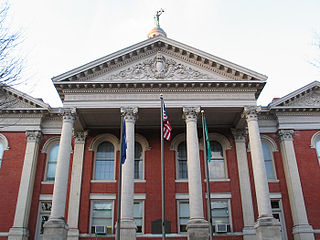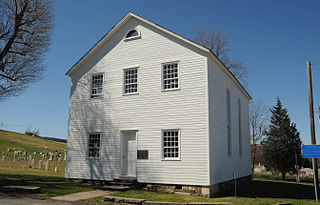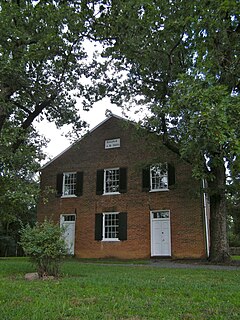Old Providence Stone Church | |
 | |
| Nearest city | Spottswood, Virginia |
|---|---|
| Coordinates | 37°57′40″N79°13′36″W / 37.96111°N 79.22667°W Coordinates: 37°57′40″N79°13′36″W / 37.96111°N 79.22667°W |
| Area | 10 acres (4.0 ha) |
| Built | 1793 |
| NRHP reference # | 72001383 [1] |
| VLR # | 007-0025 |
| Significant dates | |
| Added to NRHP | December 5, 1972 |
| Designated VLR | August 15, 1972 [2] |
Old Providence Stone Church is a historic church in Spottswood, Virginia in Augusta County, Virginia.

Spottswood is an unincorporated community in Augusta County, Virginia, United States. Spottswood is located at the junction of State Routes 620 and 671 15.5 miles (24.9 km) south-southwest of Staunton. The James Alexander House and the Old Providence Stone Church, which are listed on the National Register of Historic Places, are both located near Spottswood.

Augusta County is a county located in the Shenandoah Valley on the western edge of the U.S. commonwealth of Virginia. It is the second-largest county in Virginia by total area, and it completely surrounds the independent cities of Staunton and Waynesboro. The county seat of Augusta is Staunton, although most of the administrative services have offices in neighboring Verona.
A log structure was built in the area by 1743 for early settlers known as the South Mountain Meeting House. In 1746 the congregation split, and the stone building was built in 1793 on land donated by Patrick and Susana Hall. In 1844, Associate Reformed Presbyterian Church of the South. In 1859, a new building was built for services, and a school used the stone building until the American Civil War, and then a store and residence. From 1888 it was used as a high school for the valley until the early 20th century, and then a meeting room until a fire in 1959 destroyed the interior. [3]

The Associate Reformed Presbyterian Church (ARPC), as it exists today, is the historical descendant of the Synod of the South, a Synod of the Associate Reformed Church. The original Associate Reformed Church resulted from a merger of the Associate Presbytery and most of the Reformed Presbytery in Philadelphia in 1782. The northern Synods eventually merged with the forebearers of the PC(USA). It is one of the oldest of the United States' theologically and socially conservative denominations.

The American Civil War was a civil war fought in the United States from 1861 to 1865, between the North and the South. The most studied and written about episode in U.S. history, the Civil War began primarily as a result of the long-standing controversy over the enslavement of black people. War broke out in April 1861 when secessionist forces attacked Fort Sumter in South Carolina shortly after Abraham Lincoln had been inaugurated as the President of the United States. The loyalists of the Union in the North proclaimed support for the Constitution. They faced secessionists of the Confederate States in the South, who advocated for states' rights to uphold slavery.
The building is a simple gable structure with 18-inch (46 cm) thick walls, about 25 feet (7.6 m) wide and 70 feet (21 m) long. It was added to the National Register on December 5, 1972. [3]
Robert McCormick (1780–1846), patriarch of the McCormick family which includes Cyrus McCormick, is buried in the cemetery, along with other members of the family. [4] The McCormick Estate just to the south is now a historic museum and experimental farm. [5] The parents of sewing machine inventor James Edward Allen Gibbs are also buried in the small stone walled cemetery near the old church. A new church and larger modern cemetery are across the State Route 919 (known as "Old Providence Road) to the east. [3]

Robert McCormick Jr. was an American inventor, who invented numerous devices including a version of the reaper which his eldest son Cyrus McCormick patented in 1834. Although he lived his life in rural Virginia, he was patriarch of the McCormick family that became influential throughout the world, especially in large cities such as Chicago, Washington, D.C. and New York City.

The McCormick family of Chicago and Virginia is an American family of Scots-Irish descent that attained prominence and fortune starting with the invention of the McCormick Reaper a machine that revolutionized agriculture, helped break the bonds of slavery, and established the modern grain trade by beginning the mechanization of the harvesting of grain. Through the McCormick Harvesting Machine Company and later, the International Harvester Company and other investments, the McCormicks became one of the wealthiest families in America. The name became ubiquitous in agriculture starting in the 19th century and the press dubbed the McCormicks the "Reaper Kings". Later generations expanded into media and publishing, finance, and real estate. Various family members were well known as civic leaders. They are descended from an influential leader of modern agriculture, inventor Robert McCormick Jr. (1780–1846), and Mary Ann "Polly" Hall of Steeles Tavern, Virginia.

Cyrus Hall McCormick was an American inventor and businessman who founded the McCormick Harvesting Machine Company, which later became part of the International Harvester Company in 1902. Originally from the Blue Ridge Mountains of Virginia, he and many members of his family became prominent residents of Chicago.





















